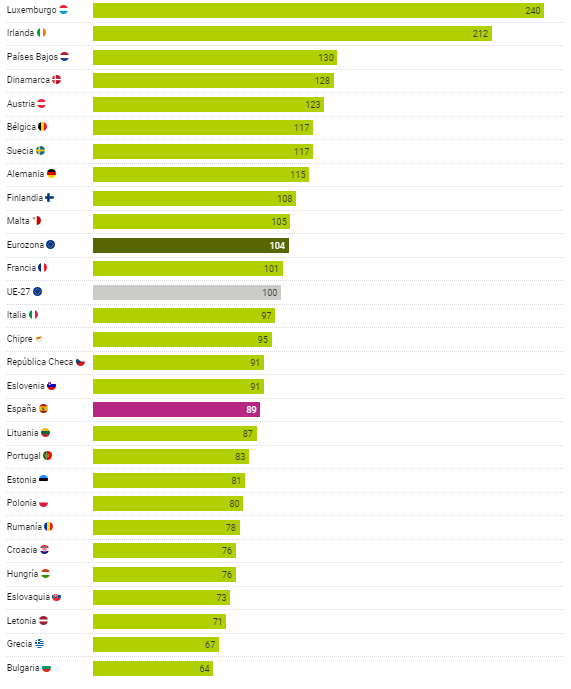
In 2023, Spain reached a Gross Domestic Product (GDP) per capita expressed in purchasing power standards equivalent to 89% of the EU measure (100), after reducing the gap with the EU-27 by three percentage points compared to 2022. However, it is still below the level of 91% corresponding to 2019, the last year before the impact of the Covid-19 pandemic.
According to Eurostat data, Spain would be the sixteenth country in the EU taking into account the criterion of GDP per capita expressed in purchasing power standards, 11% below the EU-27 average and 15% of the estimate for the eurozone.
Despite the gradual improvement in recent years, after having fallen to 83% in 2020, Spain would still be below the level of 91% in 2019, before the pandemic, and very far from the 105% maximum recorded in 2006, before the global financial crisis. In fact, between 2002 and 2009, Spain managed to maintain an income level based on purchasing power above the EU average.
The most outstanding results
The EU statistical agency highlights the "substantial differences" observed in 2023 among EU countries, as Luxembourg and Ireland had the highest levels (140% and 112% above the EU average, respectively), well ahead of the Netherlands (30% above the EU average), Denmark (+28%) and Austria (+23%). In contrast, Bulgaria recorded the lowest GDP per capita, 36% below the EU average, followed by Greece (-33%) and Latvia (-29%).
In its analysis, Eurostat warns that Luxembourg partly owes its high level of per capita income to the large share of cross-border workers in total employment, who contribute to GDP, but are not taken into account as part of the resident population when calculating GDP per capita.
Likewise, in the case of Ireland, the high level of GDP per capita can be explained in part by the presence of large multinationals that own intellectual property, whose activity contributes to the GDP, although a large part of the income is returned to the companies' final owners abroad.
These are the results for each country:

